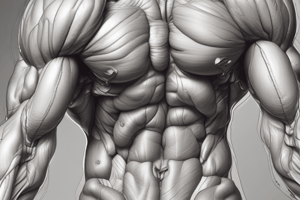Podcast
Questions and Answers
What is the primary role of creatine phosphate in muscle contraction?
What is the primary role of creatine phosphate in muscle contraction?
- To facilitate the release of neurotransmitters
- To store calcium ions
- To quickly regenerate ATP (correct)
- To provide a long-term energy source
Which neurotransmitter is primarily involved in muscle contraction?
Which neurotransmitter is primarily involved in muscle contraction?
- Dopamine
- Acetylcholine (Ach) (correct)
- Serotonin
- Norepinephrine
During which type of respiration is ATP produced without oxygen?
During which type of respiration is ATP produced without oxygen?
- Electron transport chain
- Aerobic respiration
- Oxidative phosphorylation
- Anaerobic respiration (correct)
What structural unit is described as the functional contractile unit of skeletal muscle?
What structural unit is described as the functional contractile unit of skeletal muscle?
What happens to the muscle when rigor mortis sets in?
What happens to the muscle when rigor mortis sets in?
Flashcards
Sarcomere
Sarcomere
The basic functional unit of a muscle fiber, responsible for muscle contraction. It's the repeating unit containing actin and myosin filaments.
A band
A band
The dark band of the sarcomere containing thick myosin filaments. It remains the same length during muscle contraction, while the I band shortens.
I band
I band
The lighter band of the sarcomere containing only thin actin filaments. It shortens during muscle contraction.
Ach
Ach
Signup and view all the flashcards
Ach-ase
Ach-ase
Signup and view all the flashcards
Study Notes
Muscle Structure and Function
- Sarcomere: The fundamental unit of muscle contraction. It's composed of overlapping protein filaments, actin and myosin.
- I band: Region of the sarcomere containing only actin filaments.
- A band: Region of the sarcomere containing both actin and myosin filaments.
- Muscle layers: Organized muscle tissue includes different layers from fascicles to individual muscle fibers.
Muscle Contraction
- Calcium: Crucial for muscle contraction, it's released from the sarcoplasmic reticulum and binds to troponin, initiating a series of changes leading to the sliding of actin and myosin filaments.
- Sodium: Plays a role in the transmission of nerve impulses along the motor neurons that stimulate muscle contractions.
- Acetylcholine (Ach): A neurotransmitter released at the neuromuscular junction to stimulate muscle contraction. The nerve impulse triggers release of Ach.
- Acetylcholinesterase (Ach-ase): An enzyme that breaks down acetylcholine, terminating the signal and preventing continued muscle contraction.
- Creatine Phosphate: A high-energy molecule used to quickly replenish ATP during muscle activity.
- ATP (Adenosine Triphosphate): The primary energy source for muscle contraction.
Energy Pathways
- Aerobic: Energy production that uses oxygen and yields a large amount of ATP. Longer duration of activity.
- Anaerobic: Energy production without oxygen, used for short bursts of high intensity activity; produces less ATP than aerobic.
Muscle Contraction Mechanisms
- ATP Pathways: Detailed understanding of how various energy pathways (aerobic/anaerobic) operate in generating ATP for muscle contractions is essential for comprehending muscle function. Different metabolic pathways play roles in providing ATP depending on intensity and duration of the activity.
Muscle Dysfunction
- Rigor Mortis: The stiffening of muscles after death due to the depletion of ATP, which prevents the myosin from detaching from actin.
Studying That Suits You
Use AI to generate personalized quizzes and flashcards to suit your learning preferences.



